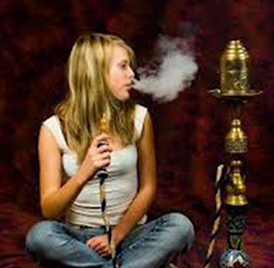Water pipe smoking (more precisely known as “hookah”, “narghil” and “shisha”) has attracted more than billion people all over the world especially that this traditional way of smoking is perhaps as old as mankind. Media tackled this kind of smoking in terms of its social problems that are considered “dangerous”. However, it cannot be denied that this tool is used daily and for long hours by more than a million persons of men and women in Asia, Africa and Europe at cafes and at homes.
Hookah, which dated back to four hundred years, originated in the East, and spread with the discovery of tobacco and the spread of cafes. It used to be accompanied with a cup of coffee. High class women used to smoke Hookah daily in their houses.
Some researchers said that a long time ago especially in the Levant, every bride trousseau had to include hookah. It is not a simple device since its length reaches sometimes two meters. It has a complex device to cool and purify the smoke by water ending with a snake-like twisted hose, which also may reach several meters in length, in addition to a number of complex issues such as the type of smoke and the means of burning this smoke and finally the time spent by Hookah lovers smoking in silence and contemplation.
As a social phenomenon, shisha smoking was concentrated in the Mediterranean countries, and practiced for long hours by all categories of people. It is curious that smoking the shisha was a thing of the past and it was linked to the lower categories of the community only, including the makers, craftsmen and the customers of the towns’ cafes.
It was also smoked in the cabins and hospices scattered on the highway, which receive drivers who want to rest and smoke shisha with a glass of black tea. They sit lazily after a long tiring manual work and enjoy smoking for a long time. But what evokes astonishment and curiosity is that shisha smoking phenomenon has returned again more strongly at the end of the twentieth and early twenty-first century by the various segments of society including intellectuals, the educated and the illiterate in different times than it was in the past. Smokers used to enjoy Shisha in evenings and at nights. Whereas now it becomes a part of the breakfast ritual. In Yemen for example, shisha was not accustomed in cafes, but nowadays, they are teeming with what is known as resting cafes which is similar to the café we know where shisha is smoked all the time by everyone, especially young boys.
Tobacco used in hookahs is known as Molasses. It is has different fruits flavors such as apples, cantaloupe, pineapple and strawberry.
It was mentioned that the beginning of smoking al-Molasses dated back to many centuries ago when jars of black honey, which were charged on a ship that carried next to honey a shipment of tobacco leaves, were broken. So honey mixed with tobacco, the merchant began to cry for his loss, then he tried to find a solution so he could save some of the consignment. He tried to smoke tobacco mixed with honey but that did not succeed , so he experimented smoking it by placing it in stone pottery and put burning coal above it
Shisha has spread faster. Authorities in different countries such as Egypt and the United Arab Emirates tried to control or even prevent Shisha smoking in hotels and public places but it was useless. In Tunisia, the authorities banned shisha smoking in public places, so some people outwitted this prohibition by putting shisha inside the cafe, and made its long hose pass through the window and smoke outdoors.
Places of smoking shisha changed from public cafes to cafeterias in the luxury hotels and places inhabited by rich people .. The customers are now from all segments of society.
Some people said that the unprecedentedly growing number of cafeterias and coffee houses, where shisha is smoked, is because of the great increase in the rate of unemployment among young people besides the lack of the social clubs that absorb the vast number of youths.
The amazing thing about hookah is that it had been developed so as to lend some sense of health security. The most surprising was that the owner of this preventive development was “Dokdok”, the illiterate cafe boy, who has no qualifications in life except his ability to proclaim in a prolonged loud voice ” you have one apple Shisha for Pasha and Salehowoowoowo!”. Dokdok decided to put a piece of aluminum paper on a piece of pottery (the stone) which contains molasses, then he enveloped the stone so well. After that he placed coal over the aluminum paper so heat could penetrate to Molasses to give the required smoke without being penetrated by the burning coal ashes. “Dokdok” thought that this “development” will beautify bubble stock rather than the stone pottery and will lead to a clean smoke.
Amal Farhat

